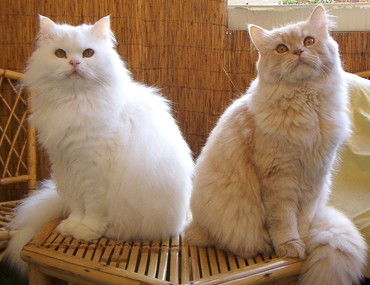History
There are lots of versions of the Persian’s history, but it is generally agreed that the breed originated in Persia in what is now Iran and Turkey. The cat made it westward and into Europe and England during the Crusades with the help of trading ships, and eventually the Persian became wildly popular among the aristocracy and royalty of Victorian England.
Some of the first Persians to arrive in England and the United States were pure white with piercing blue eyes. Known as a lazy, mellow housecat with an irresistible round head, smushed face, and long coat, the Persian is currently the most popular breed of cat in the United States!  Cat Facts
Cat Facts
Here are some interesting facts about the highly-popular Persian:
- Queen Victoria was very fond of Persians and owned multiple Blue-point Persians.
- The Persian was once called the Angora, after Ankara, the capital of Turkey.
- Weight: 10-20 pounds
- Lifespan: 10-15 years
What are they like?
What has a round head, a flat face, a snub nose, and chubby cheeks, all embedded in a ball of long, thick fur? A Persian!
Also known as Doll Face, this distinct looking cat can be described as lazy. The Persian loves serene surroundings and gentle petting, and he’ll be far more likely to lounge on the couch or in a beam of sunlight than wander around on the tops of your cabinets and furniture. The Persian gets along well with children as long as they’re gentle, and they also tend to bond well with other pets.
Playful in his own way, the Persian is a loving, affectionate cat that loves to sit in laps. He doesn’t mind spending some time alone as long as he gets some attention when his people are around.
When it comes to health, the Persian is prone to various genetic problems:
- Polycystic kidney disease (PKD)
- Breathing and sinus problems due to their flat faces and the brachycephalic (square and flat) shape of the skull
- Progressive retinal atrophy
- Hypertophic cardiomyopathy
- Bladder stones and bladder infections
- Heats stroke
Right for you?
The Persian can be a great companion, but there are always a few things to consider when welcoming a new furry friend into your home:
- The Persian’s coat is as high-maintenance as his personality is low-maintenance. Daily brushing is required by combing with a stainless steel comb to avoid tangles and mats. The fur will get everywhere, but it’s worth it to keep the cat comfortable and happy. Also, the Persian needs weekly baths. If you don’t groom a Persian, they will get matted and need to be shaved to rectify the problem. They are more prone to matting than any other breed of cat!
- If you have to travel, a pet-sitter is preferable to a boarding facility. The Persian tends to prefer his own, familiar surroundings.
- If you’re looking for a playful, animated cat that will entertain you for hours, look elsewhere. However, when it comes to the Persian, you’ll be hard-pressed to find a better lap cat.
If you have any questions or concerns, you should always visit or call your veterinarian – they are your best resource to ensure the health and well-being of your pets.
